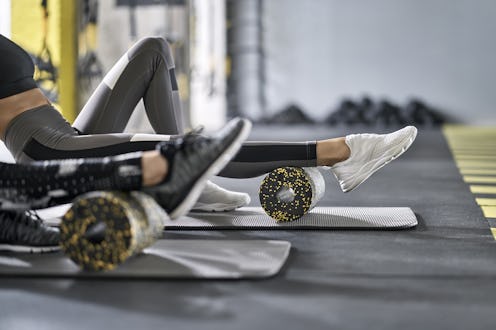(Living)
The One Thing You Probably Didn't Know Your Foam Roller Could Do

You probably already have a foam roller sitting around, potentially gathering dust. You know it's supposed to be good for you, but also don't exactly know why — besides the fact that you most certainly don't know how to use it. But based on the many foam roller benefits this piece of trendy fitness equipment has, you'll probably want to break yours out of its hiding spot ASAP.
Another buzzword in the fitness world right now is "recovery," and products from CBD to post-workout drinks are popping up just about everywhere with promises to maximize the results of your workout by preventing pain and soreness and/or keeping your body properly hydrated. That said, according to Sarah Grooms, a dancer and National Academy of Sports Medicine-certified instructor for on-demand fitness membership obé, foam-rolling might be one of the best tools around for boosting your recovery period post sweat session.
Grooms explains that the biggest reason for this is the self-myofascial release that comes from proper foam rolling. "We’ve all felt those trigger points (the parts of your body that feel extremely tight)," she says. "Foam rolling helps to release this tension, which is especially important post workout. It’s an integral part of any training regimen or workout routine. Your body will feel better the next day and ready to tackle another workout."
Celebrity trainer Lacey Stone is another big fan of the technique as a cool-down from your intensive workouts, whether you opt for an advanced yoga flow or a HIIT-based class. "I think it's more important than stretching because it goes deeper to get rid of adhesions in your muscles and connective tissue," she explains.
Some experts also believe that foam rolling can boost your body's natural ability to flush out toxins. The philosophy here is that it improves your circulation, which helps oxygenate the blood, and therefore can stimulate your lymphatic drainage system. But while Grooms confesses to the fact that this could be the case, it's actually tricky to completely confirm. That said, better circulation is something many bodily functions can benefit from.
And after your workout isn't the only time you can utilize your foam roller. In addition to the fact that it's a great tool to warm up with, some fitness professionals even use it as a tool during their workout — especially Pilates-type movements. In fact, obé has created a 10-minute routine you can do pretty much anywhere, anytime. Part of the reason some choose to do it before a more strenuous workout is because of it's ability to help prevent injury, which it does by allowing for improvements in flexibility and movement efficiency, as well as inhibiting overactive muscles, and reducing pain.
That science also applies to your regular daily body movements — not just hardcore exercise. "Our legs do a lot for us on a daily basis," says Grooms. "Even with just wearing high heels at work all day, foam-rolling is a great way to release some of the tension and prevent any future injury." Speaking of regular movements, foam rolling is also known to give you better posture overall. "[It's] not only a great way to open both the anterior and posterior chains of the body, but also allows for better posture throughout the day as muscle tightness subsides, which is ideal if you sit hunched at a desk, all day," she explains. And Stone signs off on this, adding that regular rolling "increases blood flow to your muscles and creates better mobility for everyday life."
Ready to roll? According to Grooms, one great spot to release is your IT band, which runs along your outer thigh from your pelvis to your shin. "Lie down on your side and bring the foam roller onto the outside of your thigh," she instructs. "Bend and cross your opposite leg in front of the other as you lift your hips. Slowly roll up and down the leg using your hand or elbow to balance." And if you hit a slightly tender spot (but not overtly painful — this should feel relatively good), the pro suggests that you hold for 30-90 seconds, or until the pressure releases.
If it's your calves that need a little love (hello, high heels), Grooms has another suggestion. "Sit down on your bottom with your arms slightly behind you for balance and place the foam roller horizontally underneath your calf, slightly above the ankle," she says. "Cross your opposite leg over the other to increase the compression if desired. Press into your hands to raise your hips, and slowly start rolling your body downwards so that the foam roller comes up towards your knee."
Don't have one of these miraculous, multi-purpose tools yet? Ahead, find a few different types that'll get you rolling like a pro in no time.
This article was originally published on